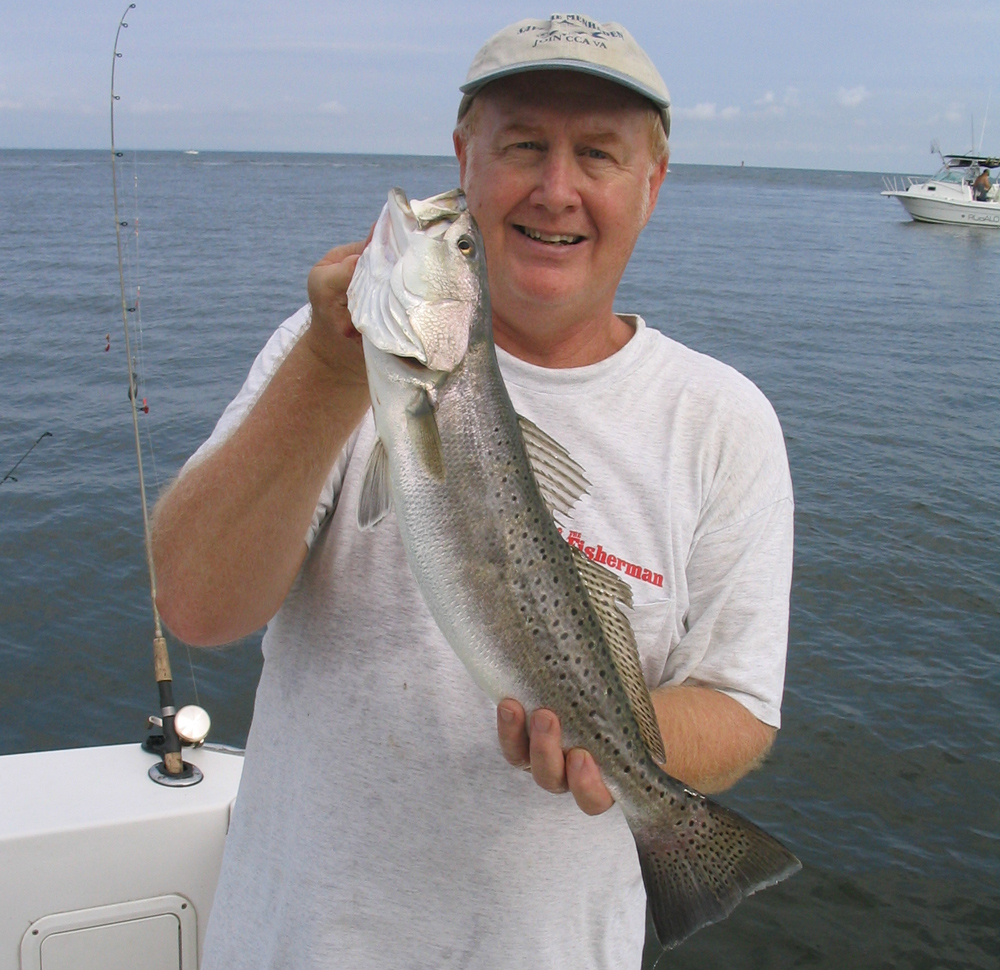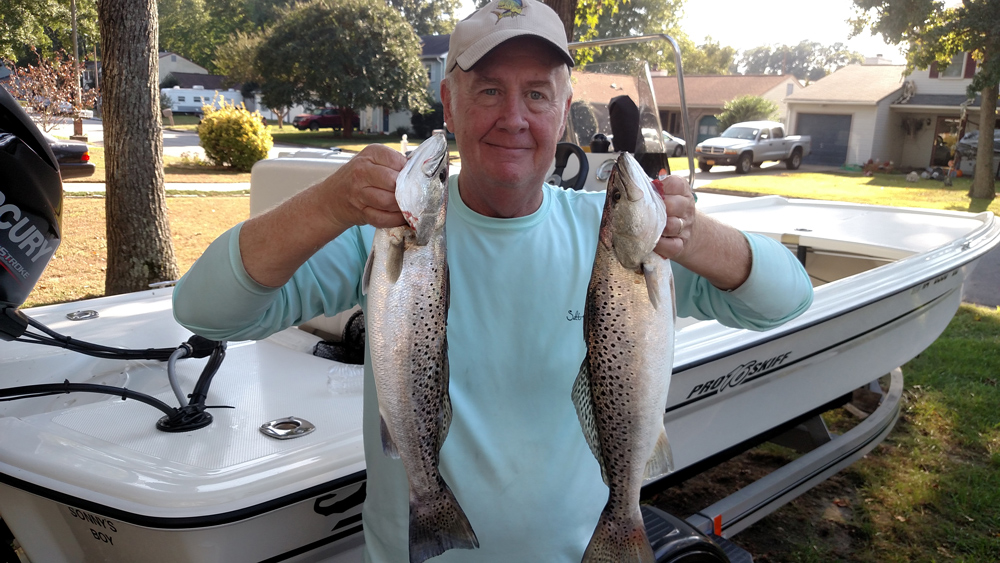Fishing for speckled sea trout in the fall is different from fishing for monster spring speckled trout, mid-summer angling, and rare dead of winter trips. Just the other day I was asked the question – you know, the question all anglers are asked at some point: “So, what’s your favorite fish?” If you mean my favorite fish to eat, I’ve got a long list. But if you’re asking what my favorite fish is to catch the list is shorter, and speckled trout are definitely on it. There’s something about hanging into a quality speck in the fall that gets me going.

Let’s start with some disclaimers. First, for the newbies in the room, a speckled trout is not the same fish as a grey trout (weakfish, yellowfin sea trout, gray trout). What we call a speckled trout is really a spotted sea trout. They are close cousins to the grey trout, both being in the drum family (making them kin to red drum, black drum, spot, and croakers). Grey trout and specks do look alike at first glance. However, the spots on the speck are well defined while grey trout are mottled, not spotted.
Another disclaimer is that specks are not really hard to find. Sure, you must know what you are doing to catch them consistently. But when they are around and you have the right bait, they’re aggressive feeders. They’re seasonal fish and in our area, you’ll have a better chance of finding them in the spring and fall. October is usually the perfect time to search for them.
Finally, speckled trout are not in trouble as a species. We’re on the northern end of their geographical range. Sure, we have good years and bad years for specks, but the biomass of these fish from the Mid-Atlantic to the Gulf is huge. Our unpredictable Virginia winters can wreak havoc on the specks and puppy (red) drum that overwinter in our estuaries, but they always seem to bounce back in a year or two.
Where To Catch Speckled Trout in Virginia
Specks are inshore fish. In years past I’ve caught them at the first and second islands of the Chesapeake Bay Bridge Tunnel (CBBT) in 20 feet of water, but that would be the farthest from shore you’re ever likely to find them in our area. They prefer shallow water (three to 10 feet) near inlets and creeks.
You’ll catch them on both the Norfolk and the Hampton sides of the Hampton Roads Bridge Tunnel (HRBT). Most of my bigger fish have come on the Hampton side. I have caught them all around the island there and my biggest speck ever came from the tube end of that island. But be careful if you decide to fish there – plenty of rocks lurk just below the surface, waiting to ruin your lower unit.
If the fish are not on the end of the island, drift down the harbor side of the island casting toward the rocks. I’ve caught plenty of nice fish there as well, also along the sea wall at the Old Point Comfort Marina. Last fall the “sharpies” were catching the big ones up inside of Muggler’s Bridge, the bridge at the end of Mellen Street in Phoebus leading to the old fort. Most of those guys were wearing waders or paddling ‘yaks. Another place for shore-bound angers to try in the fall is the Buckroe Fishing Pier. Get there an hour before sunset and fish until it’s dark just past the building, up near the beach.
Lynnhaven and Rudee Inlets hold these fish, as well, and Poquoson Flats holds some of the largest fish caught on our side of the Bay each year. The flats are about two or three feet deep, so it’s best to fish from a ‘yak or flats boat.
How To Catch Speckled Trout in Virginia
Specks like plastic – I don’t know any other way to say it. The vast majority of the fish I’ve caught have been on a half-ounce leadheads with a plastic tail. Sure, you’ll also catch them on spoons and swimming plugs, but plastics are the go-to bait. I like Gotcha “Grub” jig heads in red or white with Gulp! tails, the “New Penny” colored three-inch shrimp, or a white or yellow four-inch Swimming Mullet tail. Truth be told, this is my favorite set-up for a variety of species in the Chesapeake Bay.

Fish these lures on a light-medium fast-action spinning rod spooled with either eight-pound mono or 20-pound braid. The breaking strength is not as important as the diameter of the line, and the diameter of these two lines is similar. Tie three feet of 15- to 17-pound fluorocarbon leader directly to the running line with a double Uni knot, then tie the jig to the leader.
These fish eat by sucking the bait into their mouth, much like largemouth bass in freshwater. If it doesn’t taste right they spit it right back out, so you must feel the bite and be ready to set the hook. Once the hook is set, keep the rod tip high; quite often the fish will come to the surface and try to spit the hook by shaking its head violently (again, like a largemouth). Keep the line tight and ease him into the net.
Oh, and always use a net! These fish come unpinned from the hook easily.
Speckled trout are good to eat but don’t freeze well, so only keep enough for dinner. A five pound or 24-inch fish is good for a Virginia Citation – a framed plaque that would look good on your den wall. Unlike some species a citation speck is a bragging-sized fish, so if you get one, do what all anglers do: brag about the catch, but lie about the location where you caught it.
A few other tips…
Specks like moving water, and laying in wait for food to swim by. So try to work your jig with the current whenever possible.
Vary your retrieve but always stay close to the bottom.
They prefer early morning or late afternoon. I will often start and end my day with them, fishing for something else at mid-day.
These fish slow down as the water cools. You’ll need to slow your retrieve later in the year.
The larger the speck, the smaller the school. Young specks move around in large schools, but big old fish tend to be by themselves, or in small packs.
-By Chuck Harrison
Sign up here to get the weekly FishTalk Chesapeake Bay and Mid-Atlantic fishing reports in your email inbox, every Friday by noon.